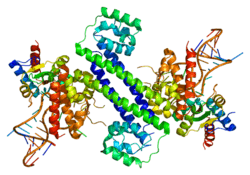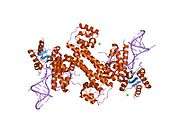PRPF31
PRP31 pre-mRNA processing factor 31 homolog (S. cerevisiae), also known as PRPF31, is a protein which in humans is encoded by the PRPF31 gene.[5]
Function
PRPF31 is the gene coding for the splicing factor hPRP31. It is essential for the formation of the spliceosome hPRP31 is associated with the U4/U6 di-snRNP and interacts with another splicing factor, hPRP6, to form the U4/U6-U5 tri-snRNP. It has been shown that when hPRP31 is knocked down by RNAi, U4/U6 di-snRNPs accumulate in the Cajal bodies and the U4/U6-U5 tri-snRNP cannot form.[6]
PRPF31 is recruited to introns following the attachment of U4 and U6 RNAs and the 15.5K protein NHP2L1. The addition of PRPF31 is crucial for the transition of the spliceosomal complex to the activated state.[7]
Clinical significance
A mutation in PRPF31 is one of 4 known mutations in splicing factors which are known to cause retinitis pigmentosa. The first mutation in PRPF31 was discovered by Vithana et al. in 2001.[5] Retinitis pigmentosa (RP) is a clinically and genetically heterogeneous group of retinal dystrophies characterized by a progressive degeneration of photoreceptors, eventually resulting in severe visual impairment.[8]
Inheritance
Mutations in PRPF31 are inherited in an autosomal dominant manner, accounting for 2.5% of cases of autosomal dominant retinitis pigmentosa (adRP) in a mixed UK population.[9] However, the inheritance pattern of PRPF31 mutations is atypical of dominant inheritance, showing the phenomenon of partial penetrance, whereby a dominant mutations appear to "skip" generations. This is thought to be due to the presence of two wild type alleles, a high-expressivity allele and a low-expressivity allele. If a patient has a mutant allele and a high-expressivity allele, they do not show disease phenotype. If a patient has a mutant allele and a low-expressivity allele, the residual level of protein falls beneath the threahold for normal function, and so they do show disease phenotype. The inheritance pattern of PRPF31 can therefore be thought of as a variation of haploinsufficiency. This variant of haploinsufficiency is only seen in two other human diseases: Erythropoietic protoporphyria, caused by mutations in the FECH gene; and hereditary elliptocytosis, caused by mutations in the spectrin gene.[10][11]
References
- 1 2 3 ENSG00000275885, ENSG00000277707, ENSG00000276421, ENSG00000277154, ENSG00000105618, ENSG00000274144, ENSG00000275117, ENSG00000274651, ENSG00000274894 GRCh38: Ensembl release 89: ENSG00000277953, ENSG00000275885, ENSG00000277707, ENSG00000276421, ENSG00000277154, ENSG00000105618, ENSG00000274144, ENSG00000275117, ENSG00000274651, ENSG00000274894 - Ensembl, May 2017
- 1 2 3 GRCm38: Ensembl release 89: ENSMUSG00000008373 - Ensembl, May 2017
- ↑ "Human PubMed Reference:".
- ↑ "Mouse PubMed Reference:".
- 1 2 Vithana EN, Abu-Safieh L, Allen MJ, Carey A, Papaioannou M, Chakarova C, Al-Maghtheh M, Ebenezer ND, Willis C, Moore AT, Bird AC, Hunt DM, Bhattacharya SS (August 2001). "A human homolog of yeast pre-mRNA splicing gene, PRP31, underlies autosomal dominant retinitis pigmentosa on chromosome 19q13.4 (RP11)". Mol. Cell. 8 (2): 375–81. doi:10.1016/S1097-2765(01)00305-7. PMID 11545739.
- ↑ Schaffert N, Hossbach M, Heintzmann R, Achsel T, Lührmann R (August 2004). "RNAi knockdown of hPrp31 leads to an accumulation of U4/U6 di-snRNPs in Cajal bodies". EMBO J. 23 (15): 3000–9. doi:10.1038/sj.emboj.7600296. PMC 514917. PMID 15257298.
- ↑ Liu S, Li P, Dybkov O, Nottrott S, Hartmuth K, Lührmann R, Carlomagno T, Wahl MC (April 2007). "Binding of the human Prp31 Nop domain to a composite RNA-protein platform in U4 snRNP". Science. 316 (5821): 115–20. doi:10.1126/science.1137924. PMID 17412961.
- ↑ "Entrez Gene: PRPF31 PRP31 pre-mRNA processing factor 31 homolog (S. cerevisiae)".
- ↑ Waseem NH, Vaclavik V, Webster A, Jenkins SA, Bird AC, Bhattacharya SS (March 2007). "Mutations in the gene coding for the pre-mRNA splicing factor, PRPF31, in patients with autosomal dominant retinitis pigmentosa". Investigative Ophthalmology & Visual Science. 48 (3): 1330–4. doi:10.1167/iovs.06-0963. PMID 17325180.
- ↑ Randon J, Boulanger L, Marechal J, Garbarz M, Vallier A, Ribeiro L, Tamagnini G, Dhermy D, Delaunay J (Nov 1994). "A variant of spectrin low-expression allele alpha LELY carrying a hereditary elliptocytosis mutation in codon 28". Br J Haematol. 88 (3): 534–40. doi:10.1111/j.1365-2141.1994.tb05070.x. PMID 7819065.
- ↑ Gouya L, Puy H, Lamoril J, Da Silva V, Grandchamp B, Nordmann Y, Deybach JC (Jun 1998). "Inheritance in erythropoietic protoporphyria: a common wild-type ferrochelatase allelic variant with low expression accounts for clinical manifestation". Am J Hum Genet. 93 (6): 2150–10. PMID 10068685.
Further reading
- Tarizzo ML (1975). "The World Health Organization and the prevention of blindness". Transactions. Section on Ophthalmology. American Academy of Ophthalmology and Otolaryngology. 79 (3 Pt 2): OP453–6. PMID 1154573.
- al-Maghtheh M, Inglehearn CF, Keen TJ, et al. (1994). "Identification of a sixth locus for autosomal dominant retinitis pigmentosa on chromosome 19". Hum. Mol. Genet. 3 (2): 351–4. doi:10.1093/hmg/3.2.351. PMID 8004108.
- Al-Maghtheh M, Vithana E, Tarttelin E, et al. (1996). "Evidence for a major retinitis pigmentosa locus on 19q13.4 (RP11) and association with a unique bimodal expressivity phenotype". Am. J. Hum. Genet. 59 (4): 864–71. PMC 1914817. PMID 8808602.
- Hartley JL, Temple GF, Brasch MA (2001). "DNA Cloning Using In Vitro Site-Specific Recombination". Genome Res. 10 (11): 1788–95. doi:10.1101/gr.143000. PMC 310948. PMID 11076863.
- Wiemann S, Weil B, Wellenreuther R, et al. (2001). "Toward a Catalog of Human Genes and Proteins: Sequencing and Analysis of 500 Novel Complete Protein Coding Human cDNAs". Genome Res. 11 (3): 422–35. doi:10.1101/gr.GR1547R. PMC 311072. PMID 11230166.
- Simpson JC, Wellenreuther R, Poustka A, et al. (2001). "Systematic subcellular localization of novel proteins identified by large-scale cDNA sequencing". EMBO Rep. 1 (3): 287–92. doi:10.1093/embo-reports/kvd058. PMC 1083732. PMID 11256614.
- Vithana EN, Abu-Safieh L, Allen MJ, et al. (2001). "A human homolog of yeast pre-mRNA splicing gene, PRP31, underlies autosomal dominant retinitis pigmentosa on chromosome 19q13.4 (RP11)". Mol. Cell. 8 (2): 375–81. doi:10.1016/S1097-2765(01)00305-7. PMID 11545739.
- Makarova OV, Makarov EM, Liu S, et al. (2002). "Protein 61K, encoded by a gene (PRPF31) linked to autosomal dominant retinitis pigmentosa, is required for U4/U6·U5 tri-snRNP formation and pre-mRNA splicing". EMBO J. 21 (5): 1148–57. doi:10.1093/emboj/21.5.1148. PMC 125353. PMID 11867543.
- Deery EC, Vithana EN, Newbold RJ, et al. (2003). "Disease mechanism for retinitis pigmentosa (RP11) caused by mutations in the splicing factor gene PRPF31". Hum. Mol. Genet. 11 (25): 3209–19. doi:10.1093/hmg/11.25.3209. PMID 12444105.
- Strausberg RL, Feingold EA, Grouse LH, et al. (2003). "Generation and initial analysis of more than 15,000 full-length human and mouse cDNA sequences". Proc. Natl. Acad. Sci. U.S.A. 99 (26): 16899–903. doi:10.1073/pnas.242603899. PMC 139241. PMID 12477932.
- Martínez-Gimeno M, Gamundi MJ, Hernan I, et al. (2003). "Mutations in the pre-mRNA splicing-factor genes PRPF3, PRPF8, and PRPF31 in Spanish families with autosomal dominant retinitis pigmentosa". Invest. Ophthalmol. Vis. Sci. 44 (5): 2171–7. doi:10.1167/iovs.02-0871. PMID 12714658.
- Scanlan MJ, Gout I, Gordon CM, et al. (2003). "Humoral immunity to human breast cancer: antigen definition and quantitative analysis of mRNA expression". Cancer Immun. 1: 4. PMID 12747765.
- Wang L, Ribaudo M, Zhao K, et al. (2003). "Novel Deletion in the Pre-mRNA Splicing Gene PRPF31 Causes Autosomal Dominant Retinitis Pigmentosa in a Large Chinese Family". Am. J. Med. Genet. A. 121 (3): 235–9. doi:10.1002/ajmg.a.20224. PMC 1579744. PMID 12923864.
- Reuter TY, Medhurst AL, Waisfisz Q, et al. (2003). "Yeast two-hybrid screens imply involvement of Fanconi anemia proteins in transcription regulation, cell signaling, oxidative metabolism, and cellular transport". Exp. Cell Res. 289 (2): 211–21. doi:10.1016/S0014-4827(03)00261-1. PMID 14499622.
- Vithana EN, Abu-Safieh L, Pelosini L, et al. (2003). "Expression of PRPF31 mRNA in patients with autosomal dominant retinitis pigmentosa: a molecular clue for incomplete penetrance?". Invest. Ophthalmol. Vis. Sci. 44 (10): 4204–9. doi:10.1167/iovs.03-0253. PMID 14507862.
- Ota T, Suzuki Y, Nishikawa T, et al. (2004). "Complete sequencing and characterization of 21,243 full-length human cDNAs". Nat. Genet. 36 (1): 40–5. doi:10.1038/ng1285. PMID 14702039.
- Grimwood J, Gordon LA, Olsen A, et al. (2004). "The DNA sequence and biology of human chromosome 19". Nature. 428 (6982): 529–35. doi:10.1038/nature02399. PMID 15057824.
- Xia K, Zheng D, Pan Q, et al. (2004). "A novel PRPF31 splice-site mutation in a Chinese family with autosomal dominant retinitis pigmentosa". Mol. Vis. 10: 361–5. PMID 15162096.
- Schaffert N, Hossbach M, Heintzmann R, et al. (2005). "RNAi knockdown of hPrp31 leads to an accumulation of U4/U6 di-snRNPs in Cajal bodies". EMBO J. 23 (15): 3000–9. doi:10.1038/sj.emboj.7600296. PMC 514917. PMID 15257298.
- Gerhard DS, Wagner L, Feingold EA, et al. (2004). "The Status, Quality, and Expansion of the NIH Full-Length cDNA Project: The Mammalian Gene Collection (MGC)". Genome Res. 14 (10B): 2121–7. doi:10.1101/gr.2596504. PMC 528928. PMID 15489334.





